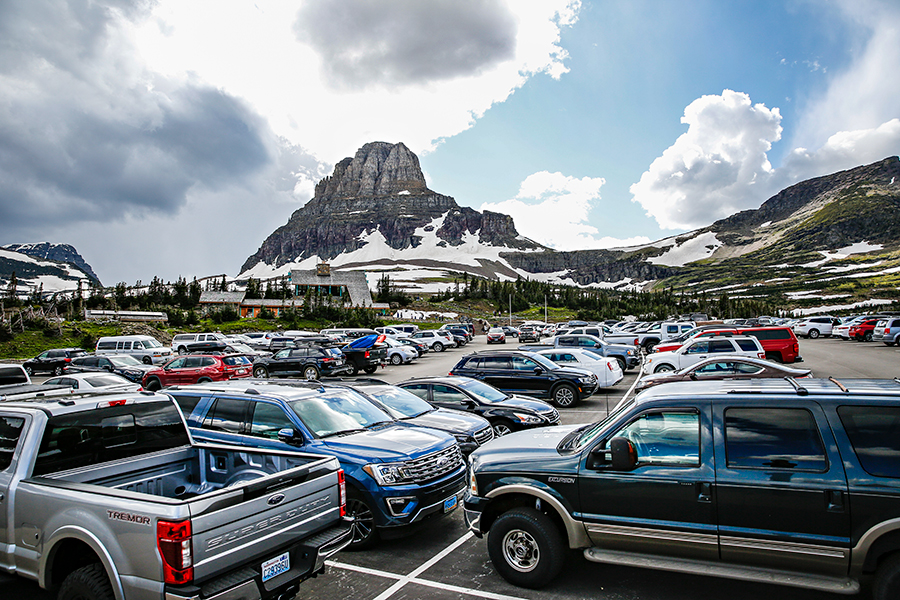If Glacier National Park were dependent on visitation to stay afloat, it would be in desperate straits this summer as administrators report a significant reduction in the overall number of people passing through its gates.
But even with visitation down nearly 60 percent so far this year — a monumental dip due to coronavirus-related closures, including a full shutdown earlier in the year and ongoing closures to the park’s eastern borders that have restricted access to nearly half of the park’s 1 million acres — administrators have taken unprecedented steps as they work to accommodate visitors who are flocking in droves to what segments remain open, managing the attendant gridlock and congestion with a “fluid and adaptive” approach that changes from day to day, a spokesperson said.
Those management decisions have included temporary closures between the park’s West Glacier entrance, which is by far the busiest, and the turnaround point at Rising Sun east of the Continental Divide. Access beyond Rising Sun is prohibited due to closures mandated by the Blackfeet Nation, whose reservation lands border the park and normally provide access to entrances along the eastern boundary.
This summer, however, amid a public health crisis that hasn’t abated, the Blackfeet opted to extend restrictions prohibiting non-essential travel on its reservation until the end of tourism season, meaning the Two Medicine, Saint Mary, Many Glacier, Belly River, Camas, and Cut Bank areas of the park cannot be accessed from the east this summer.
On July 13, when the park finally opened to vehicle traffic to Logan Pass on the west side, it marked the first time in the park’s history that the Going-to-the-Sun road has been managed as a one-way in, one-way out vehicle access with a turnaround point at Rising Sun. While the opening allowed for 29 additional miles of roadway and nine additional trailheads for visitor access from the previous closure at Avalanche, it’s constrained a summer’s worth of visitation mostly to a single segment of the park.
Other areas of the park bearing a disproportional share of the burden include Polebridge, which is located in the park’s remote northwest corner and provides access via narrow, dusty and wash-boarded dirt roads. That didn’t stop 35,651 visitors from entering Glacier through the Polebridge entrance station, up 37 percent from July of last year, when rangers ushered in 24,434 visitors through those same gates.
Year-to-date, visitation to Polebridge is up 5.1 percent, with 49,401 visitors. Those figures are despite Glacier’s two-month closure in April and May due to concerns surrounding COVID-19.
“It’s crazy,” said Will Hammerquist, owner of the Polebridge Mercantile, one of a small handful of businesses that operate just outside the park’s boundary along the North Fork Flathead River corridor. “There’s a historic lull in overall park visitation this year due to a global pandemic, and yet we’ve never been busier. Everyone is squeezing into whatever space they can find.”
At Glacier’s west entrance, the July figures show a dip over last year, with 339,454 visitors compared to last year’s 410,135, marking a nearly 19 percent drop; still, those numbers are despite the park’s two-month closure and the near-total elimination this summer of overnight options to visitors at drive-in and backcountry campgrounds.
Problems related to the spatial constraints came to a head on Sunday, Aug. 9, when park administrators were forced to begin turning incoming vehicles around at Big Bend below Logan Pass due to traffic and parking congestion before moving the closure down to Avalanche Creek and finally swinging the gates at the west entrance and restricting incoming visitors entirely.
According to Diane Sine, a public information officer for the park this summer, a series of unusual circumstances led to the restrictions, including trail closures at Avalanche Lake, where a bear frightened some hikers who then tossed their backpacks containing food, and at the Hidden Lake Trail at Logan Pass Visitor Center, where a grizzly bear has been chasing mountain goats.
Those closures may have forced more prospective hikers into their cars and on the Sun Road corridor, Sine speculated.
“We really have no way of knowing, but it may have been the perfect storm where everything aligned to create such a high degree of congestion,” Sine said. “This summer is just a whole different game, and there are so many dynamics factoring into the visitor-use patterns. We’re trying to be fluid and adaptive and learn from Sunday’s events.”
Year-to-date, 712,726 visitors have come to Glacier Park in 2020, compared to 1.6 million people through July of last year, marking a 58 percent drop.
The last time fewer than 1 million visitors arrived at Glacier at this stage of the summer was in 2008. In 2017, more than 1 million visitors came to Glacier Park in July alone.
So far in August, visitation has remained steady, Sine said.
